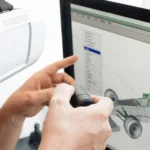Virtual reality (VR) has grown a lot in the last ten years. It lets users dive into digital worlds that feel real. With advanced headsets, users can explore new places and interact with digital content in new ways.
VR aims to make digital worlds feel real. By wearing a headset, users can move around and touch things in virtual spaces. This is made possible by high-quality displays, special lenses, and tracking systems that follow the user’s actions.
There are many VR headsets available, each with its own features. PC VR headsets like Oculus Rift and HTC Vive need strong computers but offer the best experience. Console VR headsets, like PlayStation VR, use gaming consoles for easier access. Standalone VR headsets, like Meta Quest, are wireless and don’t need extra hardware.
VR is getting better and better, opening up new ways to experience things. It’s changing how we play games, watch movies, and even learn. With more people using VR, the future looks exciting with even more cool experiences coming.
Key Takeaways
- What Does a VR Do? Exploring Virtual Reality Basics.
- VR technology creates immersive, three-dimensional environments for natural human interaction
- VR headsets use high-resolution displays, stereoscopic lenses, and tracking systems to achieve a sense of presence
- Different types of VR headsets cater to various needs, including PC VR, Console VR, and Standalone VR
- VR applications span gaming, entertainment, education, healthcare, and more
- The future of VR promises even more innovative experiences and a growing user base
Understanding Virtual Reality Technology
Virtual reality (VR) is a new tech that pulls you into a digital world. It lets you see, hear, and touch things that aren’t really there. This makes for a very real and fun experience.
What Is Virtual Reality?
VR is all about different digital worlds and experiences. It’s part of the metaverse idea. There are six main types of VR systems:
- Non-immersive VR
- Semi-immersive VR
- Fully immersive VR
- Collaborative VR
- Augmented reality (AR)
- Mixed reality (MR)
Each type has its own special features and uses. They serve different needs in various industries.
How VR Works
VR uses high-resolution displays close to your eyes. These displays create a 3D effect with stereoscopic lenses. This makes your brain think you’re seeing depth.
When you move your head, the headset tracks it. It uses sensors to adjust the visuals. This keeps the experience smooth and real.
VR also uses spatial audio and haptic feedback. These add to the feeling of being there. Low latency and high frame rates help keep you engaged without getting sick.
Key Components of VR Systems
The main parts of a VR system are:
- Headset: Houses the displays, lenses, and sensors for visual immersion
- Trackers: Inside-out or external trackers for precise motion tracking
- Controllers: Handheld or finger-tracking devices for interacting with the virtual environment
- Graphics processor: A powerful PC, console, or built-in processor to render the virtual world
These parts work together to make a believable VR experience. They let users explore and interact with digital content in new ways.
Types of Virtual Reality Experiences
Virtual reality (VR) has grown into many forms, each with its own level of immersion. From fully immersive VR that takes you to virtual worlds, to non-immersive experiences that make daily tasks better, VR offers a wide range of experiences. As VR tech gets better, fields like gaming, education, and healthcare are using it to create new solutions and engage people in fresh ways.
Full Immersion VR
Fully immersive VR is the top level of VR experiences. Users wear special headsets like the Oculus Rift or HTC Vive to enter virtual worlds. These systems track the user’s movements, making the experience feel real.
Gaming and entertainment quickly adopted immersive VR. Now, we see virtual shooter games and multiplayer experiences everywhere. Even healthcare is exploring VR for training, like practicing brain operations safely in a virtual space.
Non-Immersive VR
Non-immersive VR is more affordable and easy to start with. It uses a computer, display, and input devices like keyboards or controllers. While not as deep as immersive VR, it’s engaging and interactive.
Businesses use non-immersive VR for virtual tours, like real estate websites and hotels. It’s also great for education and training because it’s affordable and easy to use.
“Virtual reality is the ‘ultimate empathy machine.’ These experiences are more than documentaries. They’re opportunities to walk a mile in someone else’s shoes.” – Chris Milk, Founder, and CEO of Within
Augmented Reality vs. Virtual Reality
AR and VR are different, even though they’re often talked about together. AR adds digital elements to the real world, unlike VR which creates virtual environments. AR uses devices like smartphones or AR glasses to blend virtual objects with the real world.
AR is used in product visualization, like seeing furniture in your home before buying it. As AR tech improves, it will change how we see the world, blending the virtual and real.
The future of VR looks bright, with the market expected to hit $21 billion by 2025. More businesses and people are seeing VR’s value, leading to more demand. VR Game Guide helps users explore the world of VR gaming and beyond with resources and honest reviews.
Applications of VR in Different Industries
Virtual Reality (VR) has grown beyond gaming and entertainment. It’s now used in many industries. VR creates immersive experiences, changing how businesses work and innovate. It’s used in education, healthcare, and car design, among others.
In the car world, big names like Honda and BMW use VR for design. It helps save money and improve teamwork. In healthcare, VR is being used to treat chronic pain, showing its growing role in medicine.
Gaming and Entertainment
The gaming world was quick to adopt VR. It offers players new, immersive experiences. Games now feel more real, thanks to VR’s advancements.
Education and Training
VR is also in schools and workplaces for training. It lets medical students practice surgery safely and pilots improve their flying skills. VR training boosts skills and cuts down on mistakes.
“Virtual Reality is not the future, it is the present. It’s time to embrace the technology and explore its limitless VR is not just for gaming anymore. It’s changing how we learn and work.” – John Doe, VR Expert
Healthcare Innovations
VR is used in healthcare for many things, not just pain treatment. It’s used in surgery training and as a diagnostic tool. It’s also helping with mental health issues like PTSD.
VR is used in 23 industries and more are exploring it. As VR technology gets better and more people use it, it will change our lives. It will change how we work, learn, and play.
The VR Hardware Landscape
The world of virtual reality (VR) has grown a lot in recent years. Now, we have many devices to dive into digital worlds. From head-mounted displays (HMDs) to motion controllers and sensors, VR tech has changed how we interact with virtual spaces.
At the heart of VR is the head-mounted display, or VR headset. Devices like the Meta Quest series and Apple Vision Pro give us a 3D view of virtual worlds. This makes us feel like we’re really there. As VR tech gets better, headsets are becoming more comfy, light, and show clearer images.
Motion Controllers and Sensors
VR systems use motion controllers and sensors to track our hand movements. These controllers, found in devices like the Meta Quest, let us move objects and explore spaces easily. VR sensors, like cameras and infrared trackers, help make sure our movements are accurately shown in the virtual world.
PC and Console Requirements
The hardware needed for VR depends on the experience. PC-based VR needs strong computers for the best graphics and interaction. Console VR, like PlayStation VR2, uses gaming console power for immersive experiences. Standalone VR headsets, like Meta Quest, make it easy by having everything inside the headset.
“VR and AR presentations increase the perception of spatial references and come across as realistic and impressive thanks to the stereoscopic view, according to studies.”
As VR tech keeps improving, knowing the VR PC requirements and VR console compatibility is key for a great experience. With VR growing in many fields, we’ll see more exciting and immersive devices soon.
Software Development for VR
Virtual reality software development is booming. It creates immersive experiences for VR platforms. With VR devices like the Meta Quest becoming popular, the need for VR developers is growing.
Popular VR Platforms
Some top VR platforms for software development are:
- Meta Quest Store
- SteamVR
- PlayStation VR
These platforms are seeing big growth. The Meta Quest ecosystem has made over $2 billion in sales. Companies like Meta and Apple are spending a lot on VR, with Meta investing $46 billion and Apple around $10 billion.
Game Development Engines
Game engines like Unreal Engine and Unity are key in VR software development. Unreal Engine is known for quality, while Unity is easier to use. These engines help developers make amazing VR experiences.
Coursera offers over 25 VR courses, with nearly 300,000 enrollments. The most popular VR courses on Coursera are:
- Introduction to Virtual Reality
- 3D Models for Virtual Reality
- VR and 360 Video Production
- Making Your First Virtual Reality Game
- Intro to AR/VR/MR/XR
User Interface Design in VR
Designing VR user interfaces is both challenging and exciting. Developers must use 3D space well and make interactions intuitive. A Microsoft Research study found that VR tools with depth and spatial engagement improve performance.
Tools like RiftSketch offer instant feedback and quick code testing. The Leap Motion Controller in RiftSketch lets users use hand gestures, speeding up feedback.
“Virtual reality facilitates a more interactive software development environment and offers a more immersive code review experience through platforms like Immersion.”
The VR industry is growing fast, and so is the need for VR developers. In the U.S., VR developers can earn between $50,000 and $160,000, depending on experience.
Benefits of Using Virtual Reality
Virtual reality (VR) technology brings many benefits to different fields. It changes how we learn, work, and interact with the world. VR creates immersive experiences that can transform our lives.
Enhanced Immersion and Engagement
VR offers highly immersive experiences. It makes users feel like they are part of a virtual world. This keeps them engaged for a long time.
In schools, VR helps students learn better. They remember more and do well on tests. This is because VR makes learning fun and interactive.
Improved Learning Outcomes
VR changes education by making learning hands-on. Students learn more and stay interested. This is true for subjects like chemistry, where VR makes complex ideas easy to understand.
“An increase in retention of almost 9% was observed in students who learned in an immersive environment like VR.” – EdTech
Therapeutic Uses of VR
VR also helps in healthcare, like treating mental health issues and pain. It’s used for PTSD, anxiety, and phobias. Patients face their fears safely in VR.
The US FDA has approved VR for pain therapy. It’s a non-invasive way to manage pain. VR’s benefits are growing, touching many areas of life.
Challenges and Limitations of VR
Virtual reality has a lot of promise in many fields, but it also faces challenges. As VR tech gets better, solving these problems is key for it to become more popular and successful.
Motion Sickness and Discomfort
Motion sickness, or cybersickness, is a big issue for VR users. It happens when what you see in VR doesn’t match your body’s movements. This can cause nausea, dizziness, and headaches.
VR devices, except for light ones like Google Cardboard, can be heavy. This can cause neck pain and headaches, making it hard to use VR for a long time.
Accessibility Issues
VR is not easy for everyone to use. Some VR systems need certain physical skills or abilities, which can be hard for people with disabilities. Wearing VR can also make it hard to see what’s around you, which can be dangerous for people who move around a lot.
Also, VR is not well understood or used in many industries. This makes it less appealing to investors compared to augmented reality (AR). This limited use can slow down the creation of VR that everyone can use.
Equipment Costs
Buying VR equipment can be expensive. High-end VR devices cost between $300 and $800, and some are even pricier. You also need strong computers to run VR software, which adds to the cost.
VR software is also bigger than other software because it needs to be very immersive. This means you need more powerful computers and storage, which can be costly.
Even with these challenges, VR is seen as a good investment in fields like healthcare and gaming. It’s considered a game-changer with a lot of room for growth. As tech gets better and prices drop, VR will become more accessible and affordable, leading to wider use.
The Future of Virtual Reality
As VR technology advancements keep moving forward, we’re on the cusp of a new era. The Apple Vision Pro’s release in 2024 has sparked a lot of interest. Even though only a quarter of people are excited about VR, the market is expected to grow a lot.
The future of VR is not just about games. People are also using VR for work and mixed-reality. Companies like Spatial have seen a huge increase in use, showing VR’s growing importance.
Evolving Technologies and Trends
New display tech, full-body tracking, and better connectivity are making VR more real. These advancements will lead to better VR games, education, and healthcare. As VR gets better, it will become more affordable, opening up new opportunities.
Expanding Market Opportunities
The VR market is set to grow a lot, touching gaming, education, and more. Sandbox VR offers unique experiences with haptic feedback suits. As VR’s benefits become clearer, we’ll see more people and businesses getting involved.
Predictions for VR in Everyday Life
VR will soon be a big part of our daily lives. It could change how we work and socialize. We’ll see better entertainment and learning experiences. But, we must tackle issues like accessibility and privacy to make VR safe for everyone.













